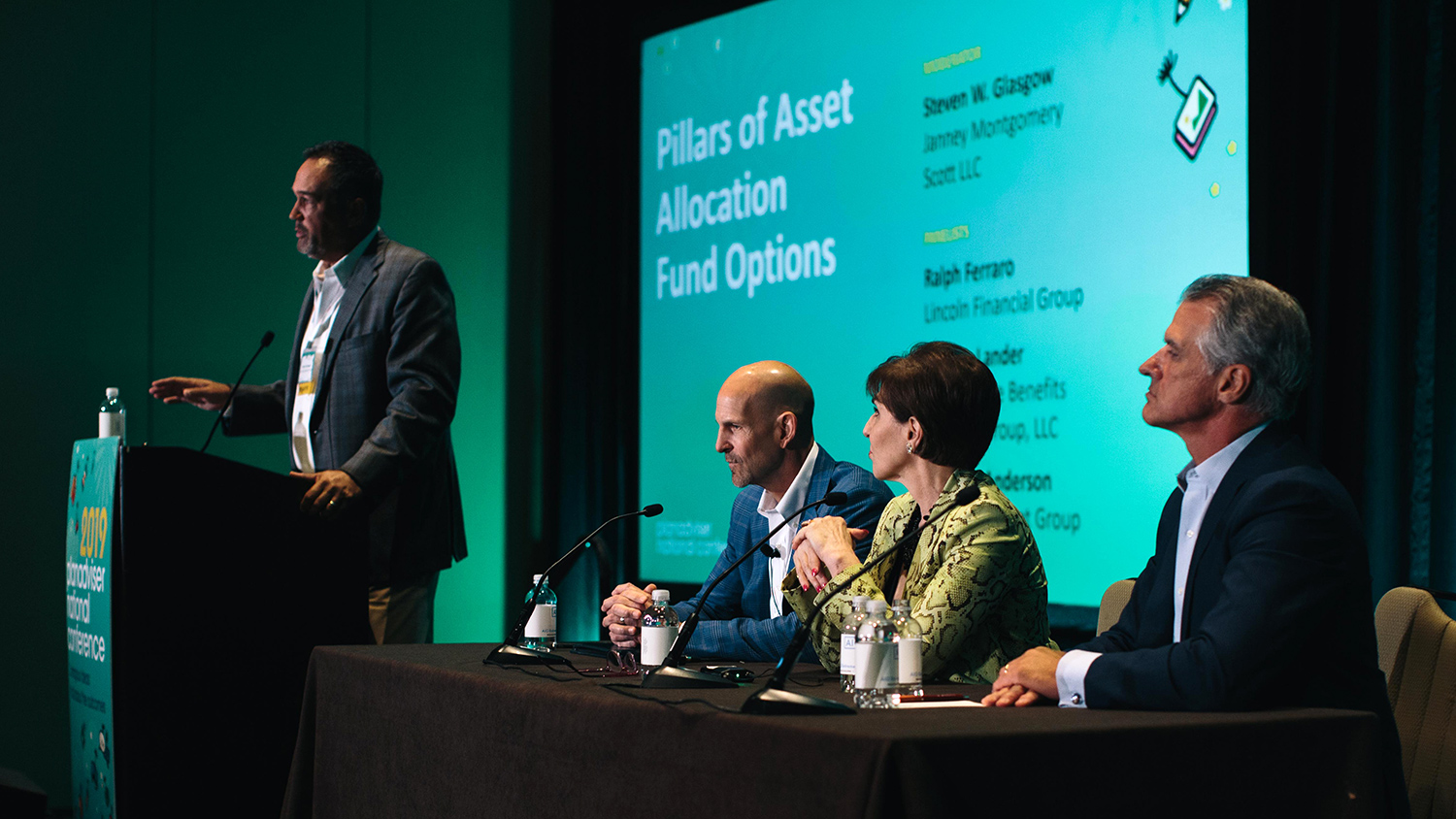Never miss a story — sign up for PLANADVISER newsletters to keep up on the latest retirement plan adviser news.
PANC 2019: The Pillars of Asset Allocation
Managed accounts, target-date funds, hybrid funds and risk-based models are all prevalent in today’s defined contribution retirement plan marketplace.

From left: Steven Glasgow, Janney Montgomery Scott; David Anderson, SHA Retirement Group; Ellen Lander, Renaissance Benefits Advisors Group; and Ralph Ferraro, Lincoln Financial Group. Photograph by Matt Kalinowski.
The second day of the 2019 PLANADVISER National Conference featured an in-depth discussion on retirement plan asset allocation fund options.
Steven Glasgow, executive vice president for wealth management and a financial adviser with Janney Montgomery Scott, moderated the panel, which featured Ralph Ferraro, senior vice president, head of product, Lincoln Financial Group; Ellen Lander, principal and founder, Renaissance Benefits Advisors Group; and David Anderson, partner, SHA Retirement Group.
The panel noted that target-date funds (TDFs) remain the most popular asset-allocation fund option across the retirement plan arena. However, they warned that there remain some harmful misconceptions around TDFs, such as the fact that many participants believe TDFs are guaranteed products that somehow protect them from market losses. In reality the fund structure of a TDF has nothing in itself to do with asset protection, and in fact many TDFs carry large amounts of equity risk.
“TDFs aren’t simple,” Lander emphasized. “They are complicated and need to be treated with care and diligence by all parties.”
The panel said they are optimistic about the opportunity that managed accounts present for delivering truly customized investment options to the masses. However, the speakers suggested many plan participants are not engaged enough to glean the benefit of managed accounts. They fail to go online and supply the critical information a managed account provider needs to actually customize their account in an appropriate way. The panelists said it is not uncommon at this stage to see plans with managed accounts wherein less than 10% of people have actually provided the information their managed account provider asked for.
“We need data beyond age,” Ferraro said. “We need salary, other savings and household wealth information. The increased prevalence of digital financial wellness platforms, I think, will help us move more and more in this direction over time.”
The panelists noted there is actually a similar engagement issue that can occur when plan sponsors embrace custom target-date funds, for example offering a low-risk, moderate-risk and high-risk glide path approach. When one looks into these plans, most often the moderate-risk glide path holds the majority of the assets, in part because this is usually the default glide path set by the sponsor—but also because people perceive the middle choice as being tacitly recommended.
On the topic of dynamic qualified default investment alternatives, which see a participant first defaulted into a TDF and then switched to a managed account at a later point in their career when they would presumably be more engaged with retirement planning, the panelists mainly voiced skepticism. They suggested the practical details may prove to be too difficult to manage and cited the same concerns about the lack of engagement with existing managed accounts. However, they said such solutions may become more powerful in the future with greater data aggregation.
Thinking about the level of risk participants are carrying in their portfolios today, the panelists said it seems that many have forgotten the lessons learned in 2008. At the same time, providers are struggling to come up with products and services that effectively address sequence of returns risk.
“This is worrying when we think about the growth of TDFs since 2008,” Anderson said. “Most of these defaulted assets have not gone through a major downturn or recession, and people appear to be pretty complacent in assuming markets are going to keep going up forever. It’s the retirement red zone that should keep us up at night—people seeing their TDF drop by 40% a year before their retirement date.”
You Might Also Like:

US Recession Talks Get Louder

Financial Advisers Hone In on Private Infrastructure Investments
